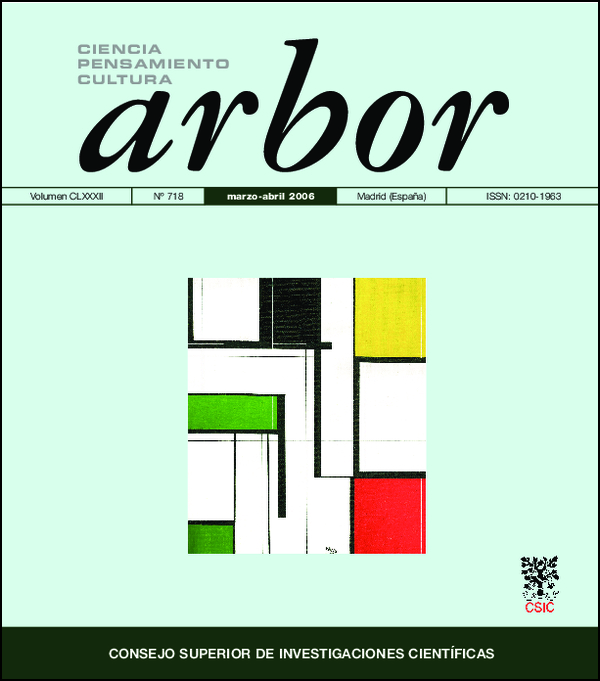La tinta invisible: Darwin y la fuerza de la herencia
DOI:
https://doi.org/10.3989/arbor.2006.i718.23Palabras clave:
Darwin, Genealogía, Herencia, VariaciónResumen
En este escrito revisamos la forma en la que Darwin interpretó algunas nociones del problema de la herencia. Primero describimos como utiliza las categorías de la herencia del siglo XIX: atavismo, constitución, genealogía, prepotencia y tendencia mórbida. Después, identificando en sus escritos el uso de esas categorías se muestra que su investigación sobre la transformación de las especies estaba conceptualmente ligada a la problemática de la herencia, pero su interpretación difirió de la corriente hereditarista, versión hegemónica a partir de la cual se ha escrito la historia de las investigaciones de la herencia.
Descargas
Citas
Barrett, P. H., et al. (1987): Charles Darwin’s notebooks, 1836-1844: Geology, transmutation of species, metaphysical enquiries, Ithaca: British Museum (Natural History) y Cornell University Press.
Churchill, F. B. (1987): “From heredity theory to Vererbung: the transmission problem, 1850 – 1915”. ISIS, 78: 336-364. doi:10.1086/354472
Darwin, Ch. (1868): The variation of animals and plants under domestication. London, John Murray. 2 Vols.
Darwin, Ch., (1871): The descent of man and selection in relation to sex. Facsímil de la primera edición. 2 vols. Princeton University Press. [1981].
Darwin, Ch. (1872): The Origin of Species, Oxford University Press, Reimpresión de la edición de 1956.
Darwin, Ch. (1876): The effects of cross and self-fertilization in the vegetable Kingdom. London, John Murray.
Darwin, Ch. (1881): “Inheritance”. A Weekly Illustrated Journal of Science. 24: 257.
Darwin, Ch. (1883): The variation of animals and plants under domestication. The Johns Hopkins University Press, Reeditada de la segunda Edición, 1998, 2 Vols.
Darwin, F. (1909): The foundations of the Origin of Species: two essays written in 1842 and 1844 by Charles Darwin. Cambridge.
Di Gregorio, M. A. (1990): Charles’s Darwin Marginalia. Garland Publishing, INC.
Gayon, J. (1998): Darwinism’s struggle for survival: heredity and the hypothesis of Natural selection. Cambridge University Press.
Galton, F. (1914): Hereditary Genius. London: Macmillan.
Galton, F. (1889): Natural inheritance. Genetics Heritage. Press, New Mexico. (ed. Facsimilar, 1997).
Hodge, M. J. S. (1985): “Darwin as a Lifelong generations theorist”. En David Kohn (ed.) The Darwinian Heritage. Princeton University Press. Pp. 207- 244.
López Beltrán, C. (1992): Human Heredity 1750-1870; The Construction of a Domain. Tesis doctoral. University of London.
López Beltrán, C. (2004): El sesgo hereditario. Ámbitos históricos del concepto de herencia biológica. UNAM, México.
Lucas, P. (1847-1850): Traité philosophique et physiologique de l´heréditéNaturelle dans les états de santé et de maladie du systéme nerveux, 2 vols., París, J. B. Bailliére.
Mendel, G. (1866): Experimentos de hibridación en plantas. A. Prevosti (traductor). UNAM, México.
Noguera Solano, R. y Ruiz Gutiérrez, R., (2005): “Pangénesis y vitalismo científico”, Asclepio, 57: 219-236.
Vorzimmer, P. J. (1977): “The Darwinian reading Notebooks (1838-1860)”. Journal of the History of Biology, 10: 107-153. doi:10.1007/BF00126097 PMid:11615636
Winther, R. G. (2000): “Darwin on Variation and Heredity”. Journal of the History of Biology. 33: 425-455. doi:10.1023/A:1004834008068
Descargas
Publicado
Cómo citar
Número
Sección
Licencia
Derechos de autor 2006 Consejo Superior de Investigaciones Científicas (CSIC)

Esta obra está bajo una licencia internacional Creative Commons Atribución 4.0.
© CSIC. Los originales publicados en las ediciones impresa y electrónica de esta Revista son propiedad del Consejo Superior de Investigaciones Científicas, siendo necesario citar la procedencia en cualquier reproducción parcial o total.Salvo indicación contraria, todos los contenidos de la edición electrónica se distribuyen bajo una licencia de uso y distribución “Creative Commons Reconocimiento 4.0 Internacional ” (CC BY 4.0). Puede consultar desde aquí la versión informativa y el texto legal de la licencia. Esta circunstancia ha de hacerse constar expresamente de esta forma cuando sea necesario.
No se autoriza el depósito en repositorios, páginas web personales o similares de cualquier otra versión distinta a la publicada por el editor.














